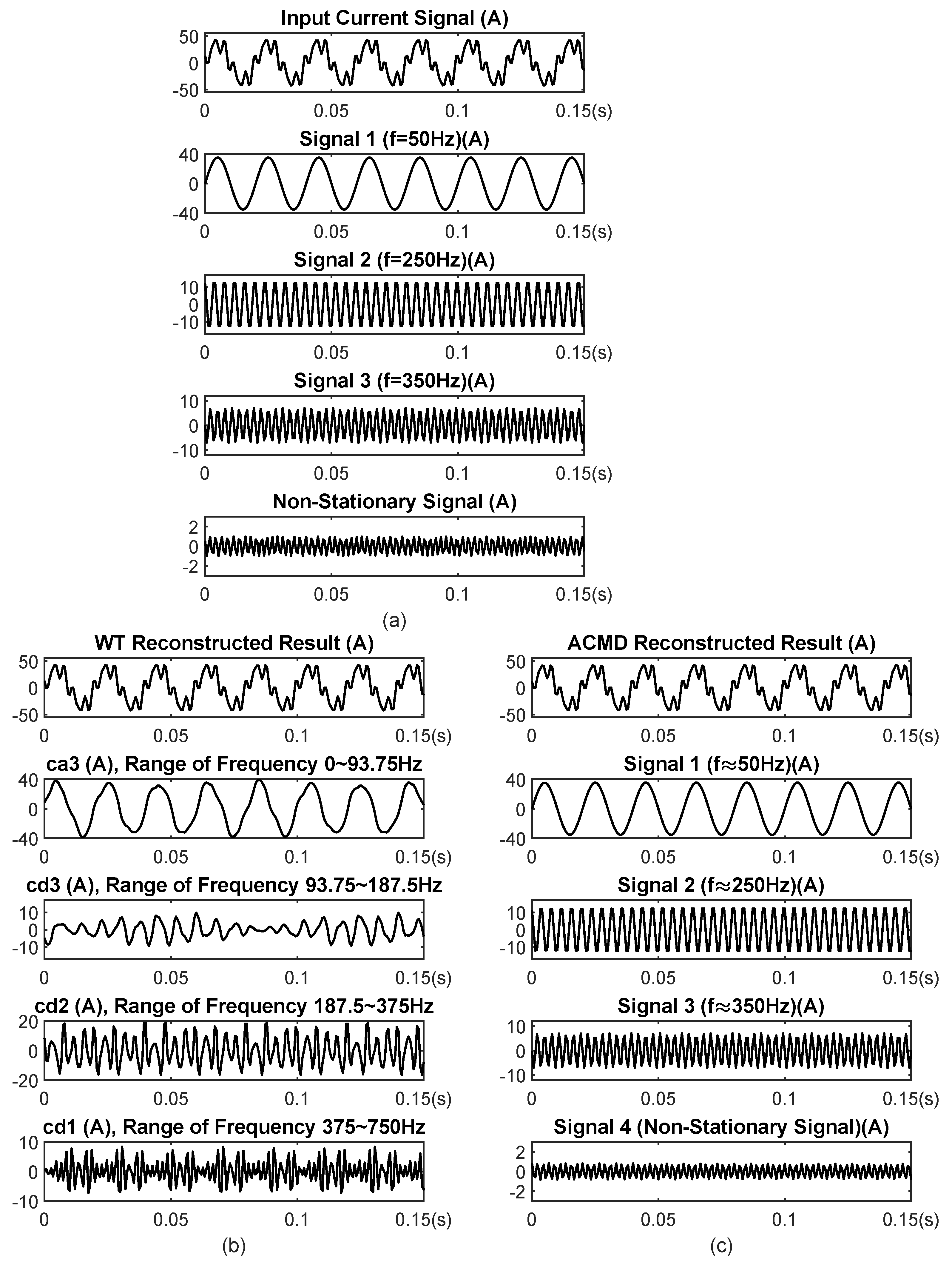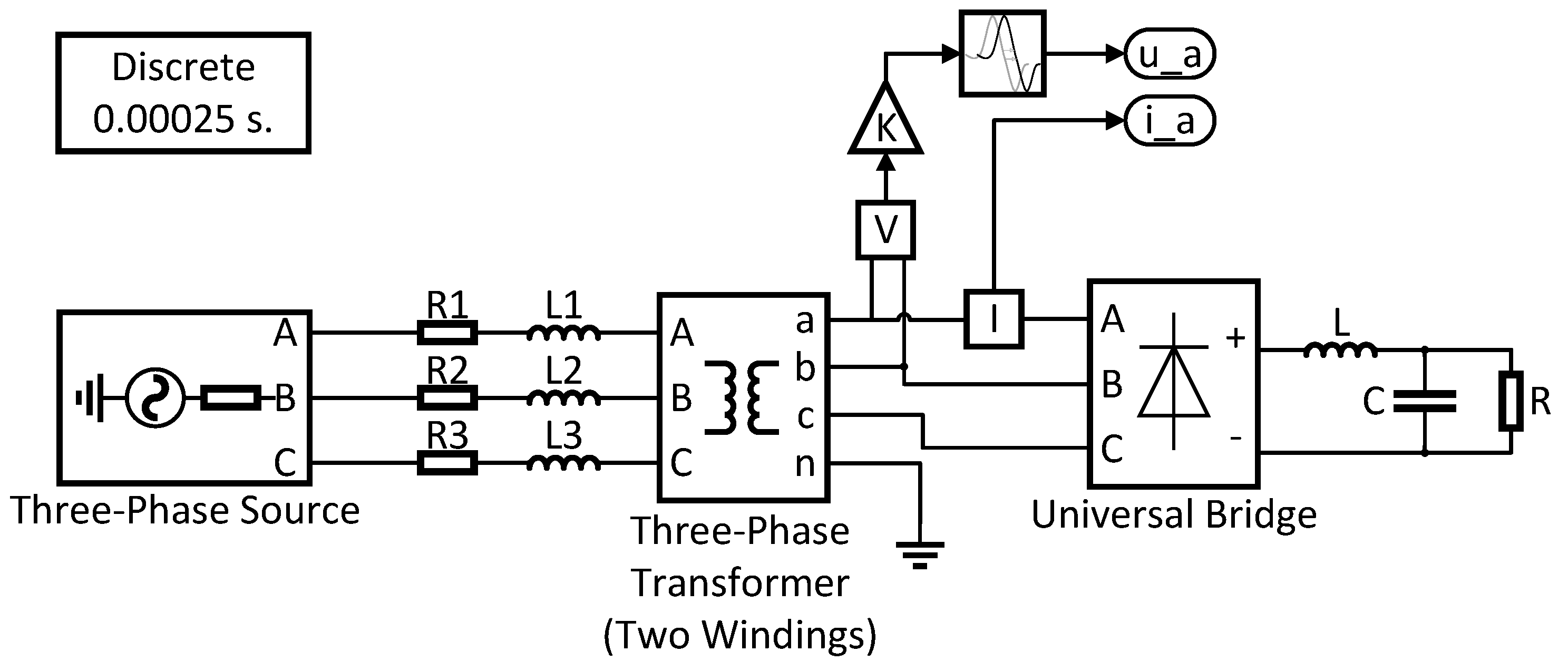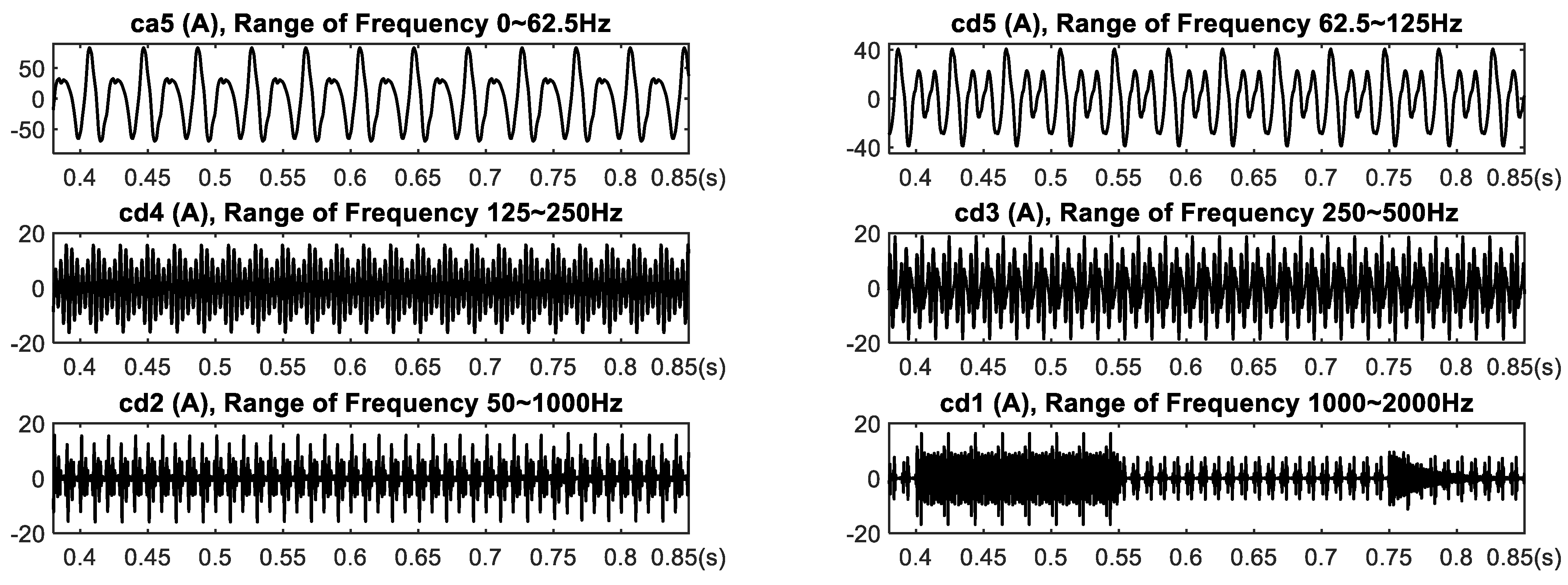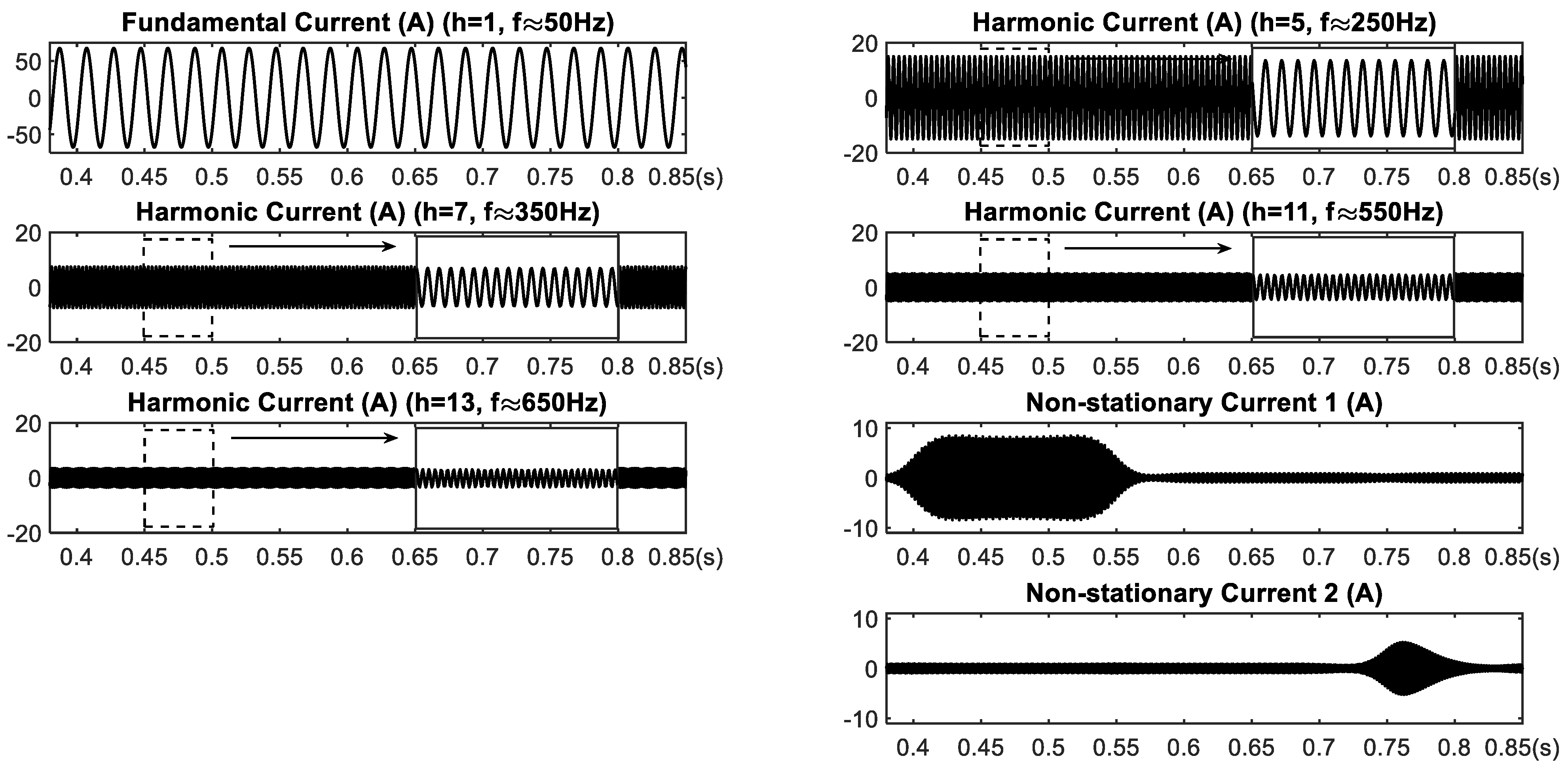Power Measurement Using Adaptive Chirp Mode Decomposition for Electrical Vehicle Charging Load
Abstract
1. Introduction
2. Proposed Method
2.1. General Mathematical Mode of Charging Voltage and Current
2.2. ACMD-Based Power-Related Calculation
2.2.1. Adaptive Chirp Mode Decomposition (ACMD)
2.2.2. Power Calculation
3. Experiments and Results
3.1. Nonstationary Synthetic Signal
3.2. Simulation Signal
4. Conclusions
Author Contributions
Funding
Conflicts of Interest
Abbreviations
| P | Active power |
| U | RMS value of the voltage |
| I | RMS value of the current |
| and | Voltage and current on the grid side of the charging piles, respectively |
| and | Fundamental voltage and current, respectively |
| and | h-th harmonic voltage and current, respectively |
| and | Nonstationary voltage and current, respectively |
| , , and | Fundamental, harmoinc, and nonstationary active power, respectively |
| , , and | RMS values of the fundamental, harmoinc, and nonstationary voltage, respectively |
| , , and | RMS values of the fundamental, harmoinc, and nonstationary current, respectively |
References
- Zhao, H.; Wang, L.; Chen, Z.; He, X. Challenges of Fast Charging for Electric Vehicles and the Role of Red Phosphorous as Anode Material: Review. Energies 2019, 12, 3897. [Google Scholar] [CrossRef]
- Liu, S.; He, K.; Pan, X.; Hu, Y. Review of Development Trend of Transportation Energy System and Energy Usages in China Considering Influences of Intelligent Technologies. Energies 2023, 16, 4142. [Google Scholar] [CrossRef]
- Ding, X.; Shi, H.; Wang, Y.; Zhuang, Y.; Yuan, G.; Zhu, S. Research on Harmonic Management of Single-Phase AC Charging Pile Based on Active Filtering. Energies 2023, 16, 2817. [Google Scholar] [CrossRef]
- Budeanu, C. Puissances Ractives et Fictives; Institut National Romain pour l’Étude de l’Aménagement et de l’Utilisation d’Énergie: Bucharest, Romania, 1927. [Google Scholar]
- Fryze, S. Active, reactive and apparent power in circuts with nonsinusoidal voltages and currents. Przglad Elektro. 1931, 1, 193–203. [Google Scholar]
- Miyasaka, G.; Silvério, E.; Xavier, G.; da Silva, H.; Braz, L.; Oliveira, R.; Lima, R.; Macedo, J. Analysis of Reactive Energy Measurement Methods Under Non-Sinusoidal Conditions. IEEE Lat. Am. Trans. 2018, 16, 2521–2529. [Google Scholar] [CrossRef]
- Pajic, S.; Emanuel, A.E. Modern apparent power definitions: Theoretical versus practical Approach-the general case. IEEE Trans. Power Deliv. 2006, 21, 1787–1792. [Google Scholar] [CrossRef]
- George, S.; Agarwal, V. A novel, DSP based algorithm for optimizing the harmonics and reactive power under non-sinusoidal supply voltage conditions. IEEE Trans. Power Deliv. 2005, 20, 2526–2534. [Google Scholar] [CrossRef]
- De Almeida Coelho, R.; Brito, N.S.D. Power Measurement Using Stockwell Transform. IEEE Trans. Power Deliv. 2021, 36, 3091–3100. [Google Scholar] [CrossRef]
- Morsi, W.G.; El-Hawary, M.E. Defining Power Components in Nonsinusoidal Unbalanced Polyphase Systems: The Issues. IEEE Trans. Power Deliv. 2007, 22, 2428–2438. [Google Scholar] [CrossRef]
- Lev-Ari, H.; Stankovic, A.M. A decomposition of apparent power in polyphase unbalanced networks in nonsinusoidal operation. IEEE Trans. Power Syst. 2006, 21, 438–440. [Google Scholar] [CrossRef]
- IEEE Std 1459-2010 (Revision of IEEE Std 1459-2000); IEEE Standard Definitions for the Measurement of Electric Power Quantities under Sinusoidal, Nonsinusoidal, Balanced, or Unbalanced Conditions. IEEE: New York, NY, USA, 2010; pp. 1–50.
- Liu, J.; Xu, Q.; Tian, Z.; Guo, Y.; Qi, S.; Wang, L. Feature Extraction Method for DC Charging Signal of Electric Vehicle. In Proceedings of the 3rd Annual International Conference on Information System and Artificial Intelligence (ISAI2018), Hong Kong, China, 24–26 June 2016. [Google Scholar]
- Morsi, W.G.; El-Hawary, M.E. Reformulating Power Components Definitions Contained in the IEEE Standard 1459-2000 Using Discrete Wavelet Transform. IEEE Trans. Power Deliv. 2007, 22, 1910–1916. [Google Scholar] [CrossRef]
- Yoon, W.K.; Devaney, M. Reactive power measurement using the wavelet transform. IEEE Trans. Instrum. Meas. 2000, 49, 246–252. [Google Scholar] [CrossRef]
- Morsi, W.G.; El-Hawary, M.E. Reformulating Three-Phase Power Components Definitions Contained in the IEEE Standard 1459-2000 Using Discrete Wavelet Transform. IEEE Trans. Power Deliv. 2007, 22, 1917–1925. [Google Scholar] [CrossRef]
- Morsi, W.; El-Hawary, M. A new perspective for the IEEE standard 1459–2000 via stationary wavelet transform in the presence of nonstationary power quality disturbance. In Proceedings of the 2009 IEEE Power & Energy Society General Meeting, Calgary, AB, Canada, 26–30 July 2009; p. 1. [Google Scholar]
- Osipov, D.S.; Dolgikh, N.N.; Goryunov, V.N.; Kovalenko, D.V. Algorithms of packet wavelet transform for power determination under nonsinusoidal modes. In Proceedings of the 2016 Dynamics of Systems, Mechanisms and Machines (Dynamics), Omsk, Russia, 15–17 November 2016; pp. 1–5. [Google Scholar]
- Alves, D.K.; Costa, F.B.; de Araujo Ribeiro, R.L.; de Sousa Neto, C.M.; Rocha, T.D.O.A. Real-Time Power Measurement Using the Maximal Overlap Discrete Wavelet-Packet Transform. IEEE Trans. Instrum. Meas. 2017, 64, 3177–3187. [Google Scholar] [CrossRef]
- Peng, Z.K.; Jackson, M.R.; Rongong, J.A.; Chu, F.L.; Parkin, R.M. On The Energy Leakage Of Discrete Wavelet Transform. Mech. Syst. Signal Process. 2009, 23, 330–343. [Google Scholar] [CrossRef]
- Wang, X.; Tang, G.; Yan, X.; He, Y.; Zhang, X.; Zhang, C. Fault Diagnosis of Wind Turbine Bearing Based on Optimized Adaptive Chirp Mode Decomposition. IEEE Sens. J. 2021, 21, 13649–13666. [Google Scholar] [CrossRef]
- Zhang, X.; Liu, Z.; Kong, Y.; Li, C. Mutual Interference Suppression Using Signal Separation and Adaptive Mode Decomposition in Noncontact Vital Sign Measurements. IEEE Trans. Instrum. Meas. 2022, 71, 1–15. [Google Scholar] [CrossRef]
- Wang, H.; Chen, S.; Zhai, W. Data-driven adaptive chirp mode decomposition with application to machine fault diagnosis under non-stationary conditions. Mech. Syst. Signal Process. 2023, 188, 109997. [Google Scholar] [CrossRef]
- Ding, C.; Wang, B. Sparsity-assisted adaptive chirp mode decomposition and its application in rub-impact fault detection. Measurement 2022, 188, 110539. [Google Scholar] [CrossRef]
- Qi, S.R. Research on the Influence of Electrical Vehicle Charging Load on Electric Energy Measurement Accuracy. Master’s Thesis, Southeast University, Nanjing, China, 2019. [Google Scholar]
- Yu, G.; Yu, M.; Xu, C. Synchroextracting Transform. IEEE Trans. Ind. Electron. 2017, 64, 8042–8054. [Google Scholar] [CrossRef]
- Chen, S.; Yang, Y.; Peng, Z.; Dong, X.; Zhang, W.; Meng, G. Adaptive chirp mode pursuit: Algorithm and applications. Mech. Syst. Signal Process. 2019, 116, 566–584. [Google Scholar] [CrossRef]
- Tong, T.; Ni, W.; Gu, D.; Cao, Y.; Yang, W. Study on the method of electric energy measurement for unsteady signal. In Proceedings of the 16th IET International Conference on AC and DC Power Transmission (ACDC 2020), Online, 2–3 July 2020; Volume 2020, pp. 1634–1640. [Google Scholar]






| Quantity | Reference Values | ACMD | DWT | |||
|---|---|---|---|---|---|---|
| Symbols | Parameters | Analytical | Value | Error (‰) | Value | Error (‰) |
| U | Voltage RMS (V) | 220.97 | 220.82 | 0.68 | 220.87 | 0.45 |
| I | Current RMS (A) | 27.39 | 27.38 | 0.36 | 27.38 | 0.36 |
| P | Active power (W) | 5625.86 | 5618.00 | 1.40 | 5602.85 | 4.09 |
| Fundamental voltage RMS (V) | 220.00 | 219.85 | 0.68 | 217.96 | 9.27 | |
| Fundamental current RMS (A) | 25.00 | 24.98 | 0.80 | 24.80 | 8.00 | |
| Fundamental active power (W) | 5500.00 | 5492.78 | 1.31 | 5399.46 | 18.28 | |
| Harmonic voltage RMS (V) | 20.62 | 20.59 | 1.45 | 35.13 | 703.68 | |
| Harmonic current RMS (A) | 11.18 | 11.17 | 0.89 | 10.85 | 29.52 | |
| Harmonic active power (W) | 125.00 | 124.66 | 2.72 | 186.88 | 495.04 | |
| Nonstationary voltage RMS (V) | 1.31 | 1.07 | 183.21 | 6.46 | 3931.29 | |
| Nonstationary current RMS (A) | 0.66 | 0.53 | 196.96 | 4.14 | 5272.72 | |
| Nonstationary active power (W) | 0.86 | 0.57 | 337.21 | 16.52 | 18,209.30 | |
| Quantity | Reference Values | ACMD | DWT | |||
|---|---|---|---|---|---|---|
| Symbols | Parameters | Analytical | Value | Error (‰) | Value | Error (‰) |
| U | Voltage RMS (V) | 224.76 | 224.77 | 0.0 | 223.88 | 3.92 |
| I | Current RMS (A) | 49.54 | 49.62 | 1.61 | 49.49 | 1.01 |
| P | Active power (W) | 10,756.46 | 10,749.33 | 0.66 | 10,659.48 | 9.02 |
| Fundamental voltage RMS (V) | 224.41 | 224.46 | 0.22 | 200.07 | 108.46 | |
| Fundamental current RMS (A) | 47.8200 | 47.83 | 0.21 | 42.74 | 106.23 | |
| Fundamental active power (W) | 10,686.11 | 10,691.48 | 0.50 | 8512.89 | 203.36 | |
| Harmonic voltage RMS (V) | 10.49 | 10.75 | 24.78 | 100.39 | 8570.06 | |
| Harmonic current RMS (A) | 12.60 | 12.74 | 11.11 | 24.69 | 959.52 | |
| Harmonic active power (W) | 48.48 | 51.07 | 53.42 | 2139.69 | 43,135.52 | |
| Nonstationary voltage RMS (V) | 2.28 | 2.47 | 83.33 | 3.78 | 657.89 | |
| Nonstationary current RMS (A) | 2.86 | 2.82 | 13.98 | 3.69 | 290.21 | |
| Nonstationary active power (W) | 6.54 | 5.79 | 114.48 | 6.89 | 53.45 | |
Disclaimer/Publisher’s Note: The statements, opinions and data contained in all publications are solely those of the individual author(s) and contributor(s) and not of MDPI and/or the editor(s). MDPI and/or the editor(s) disclaim responsibility for any injury to people or property resulting from any ideas, methods, instructions or products referred to in the content. |
© 2023 by the authors. Licensee MDPI, Basel, Switzerland. This article is an open access article distributed under the terms and conditions of the Creative Commons Attribution (CC BY) license (https://creativecommons.org/licenses/by/4.0/).
Share and Cite
Ding, H.; Tian, R.; Wang, J.; Yang, X. Power Measurement Using Adaptive Chirp Mode Decomposition for Electrical Vehicle Charging Load. Energies 2023, 16, 5305. https://doi.org/10.3390/en16145305
Ding H, Tian R, Wang J, Yang X. Power Measurement Using Adaptive Chirp Mode Decomposition for Electrical Vehicle Charging Load. Energies. 2023; 16(14):5305. https://doi.org/10.3390/en16145305
Chicago/Turabian StyleDing, Haili, Rui Tian, Jinfei Wang, and Xiaomei Yang. 2023. "Power Measurement Using Adaptive Chirp Mode Decomposition for Electrical Vehicle Charging Load" Energies 16, no. 14: 5305. https://doi.org/10.3390/en16145305
APA StyleDing, H., Tian, R., Wang, J., & Yang, X. (2023). Power Measurement Using Adaptive Chirp Mode Decomposition for Electrical Vehicle Charging Load. Energies, 16(14), 5305. https://doi.org/10.3390/en16145305






